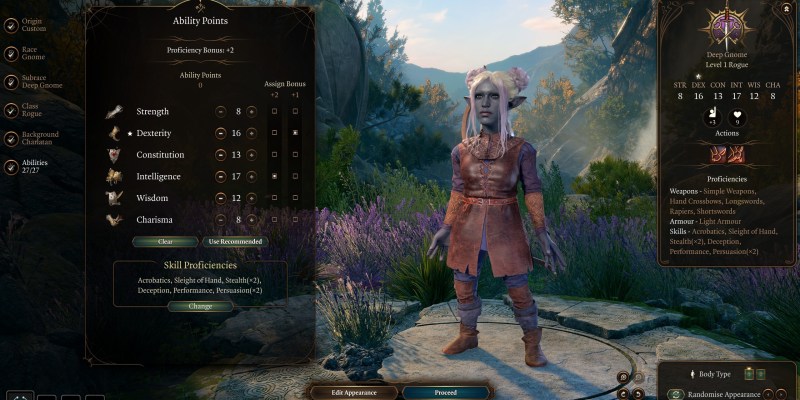Everyone loves a dashing Rogue, so why not play as one? Whether you’re a fan of sneaking, stealing, assassinating, or even casting some illusion-based spells, the Rogue class in Baldur’s Gate 3 has you covered. With deep gameplay systems that allow you to pick pockets and flit in and out of shadows, it’s a great choice for those that like to roleplay as they adventure through Faerun. Just follow our guide for the best races and ability scores for a Rogue in Baldur’s Gate 3.
At level 1, Rogues have the powerful Sneak Attack feature which allows them to deal additional damage to enemies that are unaware of them. Furthermore, level 2 introduces Cunning Actions that greatly increase maneuverability, allowing the sneaky thieves to avoid danger and reposition before dishing out more damage from the shadows. They also have Expertise in two Skills, doubling their potency.
Best Races for Rogues in Baldur’s Gate 3 (BG3)
As Baldur’s Gate 3 does away with race ability bonuses, you can freely make a Rogue of any race. That said, three races grant advantages to the class that others lack: the Elf (Wood subrace), the Half-Elf (Wood subrace), or the Gnome (Deep subrace).
Wood Elves and Half-Elves gain an extra 1.5 meters to move in combat. As melee-focused Rogues want to reach enemies and move out of danger quickly, this racial feature becomes invaluable—especially for the Thief subclass (more on that later). Deep Gnomes, on the other hand, receive a racial feature that grants them Advantage on Stealth checks, which more-or-less means that you have a second chance to successfully stay out of sight, making sneaking around much more successful.
All Rogue Subclasses
Rogues have three subclasses to choose from at level 3 that encompass all things sneaky and tricky:
- Thief: This classic subclass grants you the ability to make an extra bonus action—invaluable when Rogues already have Cunning Actions that take up bonus actions. Throw in a Rapier or two with the bonus action Flourish, and you’re dealing tons of damage each turn.
- Arcane Trickster: This subclass supplements sneaky gameplay with a variety of spells, including those to distract and debilitate.
- Assassin: Assassins deal massive damage to unaware enemies, taking them out before they take an action in combat and guaranteeing critical hits.
Best Ability Scores for Rogues in BG3
Ability scores give a modifier bonus to your dice rolls, and you have a total of 27 to allocate into six skills. Furthermore, you have the option to grant a +2 and a +1 bonus to two different abilities. This build is optimal for those that wish to deal massive Sneak Attack damage before sneaking out of danger:
Wood Half-Elf
Strength: 8
Dexterity: 17 (+2 bonus)
Constitution: 13
Intelligence: 10
Wisdom: 12
Charisma: 15 (+1 bonus)
A high Dexterity will not only grant you a bonus to Initiative (turn order), it will also increase your Armor Class for when an enemy does get to attack you. With low Strength, however, it’s best to avoid weapons that aren’t ranged or do not have the Finesse attribute on them, which allows them to scale with Dexterity instead. A high Charisma score will also allow your Rogue to be a great party leader outside of combat, receiving a bonus to skills such as Deception and Persuasion. Upon reaching level 4, selecting Ability Score Improvement to increase your Dexterity and Constitution by 1 is key in order to receive the next tier of modifier bonus.
A Rogue that looks to wield some magic, or wants to invest in Stealth even more heavily, should run a build similar to this:
Deep Gnome
Strength: 8
Dexterity: 16 (+1 bonus)
Constitution: 13
Intelligence: 17 (+2 bonus)
Wisdom: 12
Charisma: 8
At the cost of being uncharismatic and rather weak, this build goes all in with what makes an Arcane Trickster tick: high Dexterity for Sneak Attacks and the like, along with a high Intelligence score to make the use out of many of the subclass’s spells. This build is also ripe for multiclassing into the other Intelligence-based caster, the Wizard.
As for backgrounds for other builds, you should go for whichever makes the most sense for the character you wish to play rather than the skills you’ll receive. That said, Rogues receive Expertise in two skills of their choice, so picking a background with Stealth or Persuasion, for example, might be useless as you can receive double proficiency in that particular Skill. Backgrounds are much more important for garnering Inspiration Points, which are earned for fulfilling little mini-quests for whatever character you’re roleplaying as, such as protecting nature as an Outlander, or crafting a powerful weapon as a Guild Artisan. Go with what interests you—just make sure you don’t neglect Stealth proficiency for this class.
Rogues are an incredibly popular pick in games inspired by Dungeons and Dragons, as well as in the table-top juggernaut itself. With all the information provided here in our guide to the best races and ability scores for your Rogue in Baldur’s Gate 3, you should be all set to create a backstabbing, shadow-hopping, master of stealth.
We also have guides to the other races in the game and plenty other tips as well, so take a look through our archives for more information on the gam
